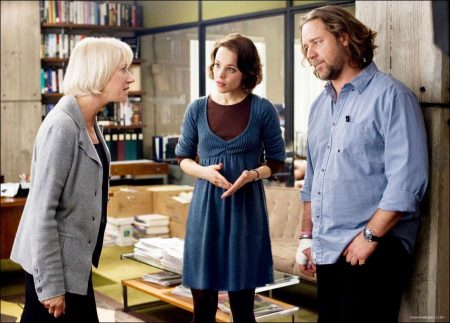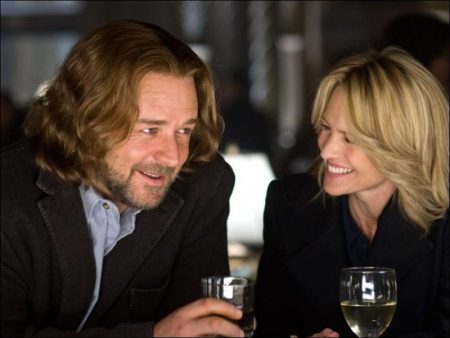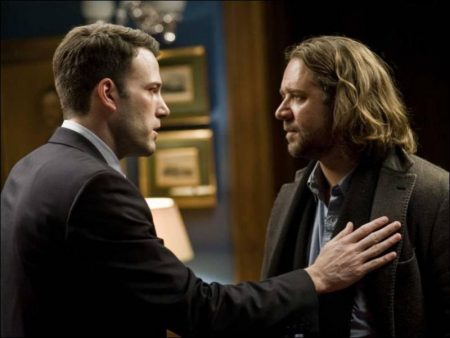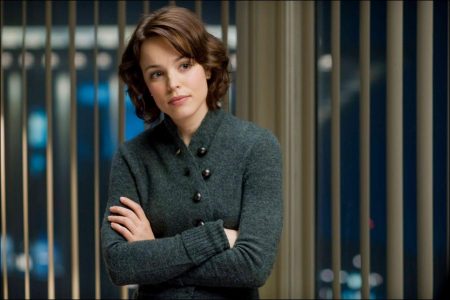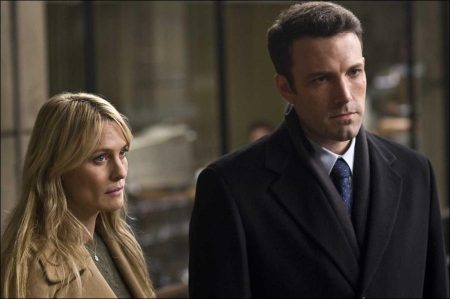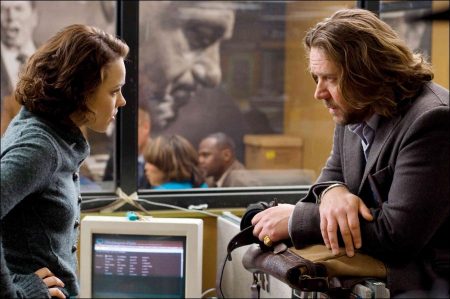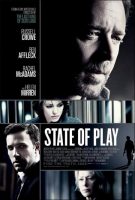Tagline: Good reporters don’t have friends, only sources.
State of Play movie storyline. In the chess match of Beltway politics, there is constant maneuvering between two worthy teams: politicians who seek to retain their positions of influence and journalists out to uncover corruption that accompanies unchecked power. What binds the opponents is their need for each other. And assassination—whether of a character or a life—is sometimes a means to their endgame.
Oscar winner Russell Crowe (Gladiator, American Gangster) leads an all-star cast in a blistering thriller about a rising congressman and an investigative journalist embroiled in a case of seemingly unrelated homicides. Crowe plays Cal McAffrey, a veteran D.C. reporter whose unyielding determination leads him to untangle a mystery of murder and collusion among some of the nation’s most promising political and corporate figures in State of Play, from Kevin MacDonald (One Day in September, The Last King of Scotland).
Ambitious, unflappable U.S. Congressman Stephen Collins (Oscar winner Ben Affleck, Hollywoodland, Gone Baby Gone) is the future of his political party: an honorable appointee who serves as the chairman of a committee overseeing defense spending. High hopes are pinned to this rising star to become a leading national figure—until his beautiful young staff assistant dies tragically and buried secrets come tumbling out.
McAffrey has the dubious fortune of having both an old friendship with Collins and a tough-asnails editor, Cameron Lynne (Oscar winner Helen Mirren, The Queen, Gosford Park), who has assigned him to investigate the story. As he and novice partner Della Frye (Rachel McAdams, The Notebook, Red Eye) try to uncover the killer’s identity, McAffrey steps into a cover-up that threatens to shake the nation’s power structures. In a town of spin doctors and wealthy politicos, he will discover one truth: When billions are at stake, no one’s integrity, love or life is beyond question.
Joining the lead cast is an accomplished team of performers including Robin Wright Penn (Beowulf; New York, I Love You) as Stephen Collins’ loyal wife, Anne; Jason Bateman (Hancock, The Kingdom) as manipulative public relations executive Dominic Foy; and Jeff Daniels (Good Night, and Good Luck.; The Lookout) as George Fergus, a powerful senator with the reputation of his party on the line.
Adaptation to Action: State of Play Begins
“You cannot connect anything back to me.” — U.S. Congressman Stephen Collins
From securing the film rights to finalizing the cast, the road to putting State of Play cameras on the streets of Washington, D.C. took as many twists and turns as a political thriller. It began with brilliant source material from writer Paul Abbott, the creator of the enormously successful and critically acclaimed 2003 miniseries that aired on the BBC. The persistence of producer Andrew Hauptman—joining with Working Title’s producers Tim Bevan and Eric Fellner—ensured the adaptation would make it to the big screen.
The BBC broadcast its premiere episode of State of Play in May 2003. Audiences and critics alike were held rapt by the intertwining stories of Stephen Collins, Cal McAffrey and their associates in politics and journalism. Soon after the series aired, Hauptman began negotiating with agents in London for feature film rights to Abbott’s work.
His tenacity led him to a meeting with Abbott at his home in Manchester. There, Hauptman convinced the writer that he would be the right man to produce a movie of Abbott’s work that would be faithful to the spirit of the source material. He closed the deal to adapt State of Play in November 2004 and began the long process of working with writers to morph Abbott’s complex six-hour miniseries into a feature film that would shift the action to the corridors of American power: Washington, D.C.
Reflects Hauptman on his interest in the longgestating project: “The original series was such a rare find in source material. It was a riveting series that grabbed you and didn’t let go; it resonated with me in so many ways. I always thought that by moving the setting to Washington D.C., its scope could be even more powerful and combustible, but just as intelligent.
“The opportunity to get inside the world of the newsroom and feel the drama associated with running a paper, chasing a story and the pursuit of the truth and all of its implications brought a lot of relevance to the story,” he continues. “What made the miniseries work so well was that on the surface it was about the dance between politics and journalism—the state of contemporary news media, corporate espionage and conspiracy. But then you realize it was also about individuals and their choices and was deeply personal. It tackled issues of conflict and compromise, loyalty and love, and power and career aspirations. That made it incredibly intriguing.”
Abbott was naturally keen to ensure his carefully constructed series not fall into the wrong hands for translation. “In my initial conversations with Paul, he was concerned about how we were going to turn a sixhour drama into a feature film,” says Hauptman. “We were both concerned about making a movie that lived up to the quality of the series.”
Hauptman spent the next several years developing the project before bringing it to Universal Pictures, which then brought in Working Title Films—where producers Tim Bevan and Eric Fellner have made a name building the most successful film production company in Britain.
Offers Fellner of Working Title’s desire to tackle the project: “Like everyone else, we were transfixed when we watched the miniseries several years ago. Paul created this universe that exposed the darkest side of humanity and its worst traits of greed, corruption and unyielding ambition. Tim and I knew it would be a huge challenge to distill that much material and draw a story from the series that would be engaging…as well as one smart enough to stand alone. We felt with Andrew and Kevin at our side and the right team ofwriters, we could do it justice.”
Finding the correct director for the project was equally painstaking. The producers made an unorthodox choice when they selected an Academy Award-winning (and two-time BAFTA winning) Scottish documentarian who was little known to the feature-film world until his explosive first feature, The Last King of Scotland, took audiences by storm.
Though his film netted Forest Whitaker the Oscar for Best Actor and was roundly lauded, Macdonald was previously a fixture among the journalism community for such powerful work as his Oscar-winning analysis of the tragic murders of athletes at the Munich Olympics, One Day in September. His specialty was in showing an unknown side of iconic men—whether they be rock or film heroes such as Mick Jagger and Howard Hawks, or mass murderers like Idi Amin and Klaus Barbie.
Recalls Hauptman of the decision: “We undertook a worldwide search looking for the right individual, and we were really lucky to come across Kevin—a guy who has a lot of integrity. He had seen the series and was moved by the themes that the work covered. As a documentarian, a lot of the themes uncovered in day-to-day news resonated with him, as did exploring those issues in the U.S.”
“When I saw State of Play on TV, I absolutely loved it,” remarks Macdonald. “Like everybody in Britain loved it, and it won every award going. Five years later, I was sent a script. I was intrigued by it, but initially suspicious, as I loved the series so much. I thought: ‘It’s six hours long. How can I make it into two hours?’”
Macdonald had no interest in simply re-shooting the work of the miniseries’ creators. “Part of the way we got around that was that we changed it rather radically,” he says. “Although the basic story is the same, there’s a lot that’s very different about it. You realize you can’t make another version of something that was good. You have to reinvent, and that’s what we’ve tried to do.”
The filmmaker was particularly intrigued by how the script for State of Play took a relevant look at the declining state of print journalism and the death to dailies in certain markets. He saw Cal McAffrey as one of the few remaining in a dying breed: a traditional journalist who scours each lead until he’s satisfied…and a newsman who files his story the night before it is made available in the printed edition of the paper.
McAffrey’s editor shoulders the corporate demand to publish scandal or perish, and Della Frye comes from a new school of reporters who are more comfortable with multitasking and instant access to information. In her world, the blogger first to publish an opinion is often the go-to expert (and frequently cited source) on the subject for future stories.
Journalists and Politicians: Casting the Production
“Did we just break the law?” — Globe blogger Della Frye
“Nope, that’s what you call damn fine reporting.” — Globe senior metro reporter Cal McAffrey
When casting the role of The Washington Globe’s veteran newsman Cal McAffrey, the filmmakers were looking for a performer who could play with grit and street smarts, but also a gruff newsman who is holding on to an old standard in the face of change. Macdonald explains of his “truth teller”: “Cal is the senior metro reporter of the newspaper—a guy who is really smart and should be the editor. He should be working in politics, but something’s held him back. He represents the nobility of journalism…but also the decline of it.”
When considering actors for the part, the team had a fortunate break. Macdonald recalls: “The studio said to me, ‘Who do you want?’ I said, ‘I want the best actor in the world, and that’s Russell Crowe.’ And they said, ‘Okay, let’s see.’ So we sent Russell the script. Three days later, I was on a plane to Australia. Twenty-four hours after that, he’d agreed to do it, and two weeks later he was on set. Russell came in, took the character by the scruff of the neck and totally understood who Cal would be.”
Hauptman was as pleased as his director at the selection of Crowe to play the hard-nosed reporter who had an affair with his best friend’s wife. “Russell feels this part; he looks it,” says the producer. “He has strong views of what journalists have become today versus the more idealized version of what they were years back. Stepping on the other side of that notepad or tape recorder, and having the investigative mind that he does, he dug to the core of who his journalist ought to be.”
Crowe found the character refreshingly atypical. “One of the things that this story goes into is the ambiguity of the concept of an objective press,” he states. “They want to tell you they’re objective and their relationships and their lives don’t affect what they write. But in this case, that’s not true. This was one of the things that interested me; they’re human. They do take things personally, and sometimes they can’t get themselves out of the story—with both good results and bad.”
The actor was interested in how this character could never be 100 percent objective, as he was investigating a murder case in which a good friend was implicated. “I see Cal as a human who has one train of thought, and that pushes him into action,” says Crowe. “But it’s not heroism; he’s doing what he feels he should of his friend. So, right from the beginning of the story, his point of view is polluted.”
McAffrey’s long relationship with both Stephen Collins and Collins’ wife, Anne, draws him into wanting to tell the story from their point of view. Initially, he loses the objectivity that is drilled into members of the fourth estate from their first day of journalism school.
As Macdonald notes: “The guilt of his affair is one of the drivers for Cal, one of the things that makes him want to prove his friend innocent.” Ultimately, however, his dispassion returns, and he falls back on ingrained professional instincts.
When casting the role of Stephen Collins, the team looked to Ben Affleck to play the congressman struggling with the murder of his staff assistant/lover, Sonia Baker. Simultaneously, the character was dealing with the collapse of his marriage and potential halt to his ascension as a power player.
The director explains of Collins: “Stephen has become chairman of this very important committee researching abuses in the Defense Department. He’s a highflier; he’s presidential material… the new Kennedy. Ben Affleck has those looks, that suavity and a huge interest in politics that make him such a great fit for this part.”
Joining the production off his acclaimed directorial debut, Gone Baby Gone, Affleck recognized in Macdonald a filmmaker with instincts he could trust. The actor interpreted Collins as imploding with the consequences of his decisions. “The moral ambiguity attracted me to this part,” says Affleck. “Here is this powerful, successful young congressman who has absolutely everything to gain…yet he throws it away by having an affair with a woman who winds up murdered. This coincides with the falling apart of his relationship and the shattering of a code he embraced in the military. I felt that Stephen believed he was trying to do right by the people in his life he cared for…he just fell apart.”
The friendship of his character with Collins leads to conflicts that Crowe found interesting to explore— especially how members of the media can leave themselves open to manipulation. He says: “Stephen Collins is a chess player who uses those skills to his advantage. He lives in a world in which agendas are pushed by friends on the inside. Same thing with the world of the press who, in their rush to beat the competition, are scrambling for inside sources who are often using them to push agendas of their own.”
The cub reporter to McAffrey’s seasoned vet, The Washington Globe blogger Della Frye first begins to put together the link between seemingly unrelated deaths. Though she may be, as Macdonald puts it, “easy with her opinions and not so hard on the facts,” Frye’s familiarity with and navigability of the world of technology makes her, initially, a most unsuitable partner for McAffrey. But the two find common ground in their drive to get to the bottom of this story.
“Rachel has this fantastic ability to come across as a complete naïf, then turn that perception on its head by skewering her antagonist,” offers producer Fellner. “Her passion for this project and chemistry opposite Russell meant there was no better option to play Della. As we watched her go head-to-head with him, we knew we’d made the ideal choice in casting.”
Like many of her generation, the actor embraces emerging technology and the instant access to information that has come with it. “I was interested in the idea of new journalism versus old,” says McAdams. “It’s a relevant issue in the face of a changing profession. But Cal’s and Della’s motivation is essentially the same: to write good stories. Her method is more of an instant gratification. She will get an assignment, do computer research, do a little firsthand research and write it up. Cal will skip the computer research and go straight to getting his hands dirty.”
The relationship of the seasoned reporter with the fresh-faced blogger was an important one for the director to explore. Macdonald appreciated the fact that the writers had crafted a story among “two people who hate each other and end up not in love, but bonded. One of the things I love about their relationship—the central relationship of the film—is that it’s one between an older man and a younger woman and it’s not sexual; it’s a mentor-mentee connection. You don’t see that very much in film.”
Robin Wright Penn was cast in the role of Anne Collins, a woman caught between loyalty to a husband whose ideals she still admires and a longing for intimacy she no longer knows in her marriage. It doesn’t help matters for Anne that she is still in love with her husband’s closest friend, Cal McAffrey. As an admirer of Macdonald’s earlier work, Wright Penn was eager to join the project when she learned of the director. She was impressed by the level of intelligence and insights in his documentaries and felt he would know how to execute the steps that combine to make a successful political thriller.
Hauptman was particularly touched by the actor’s passion to tell Anne’s story, one that is all too common in the media: The wife of a successful political representative stands by a caught philanderer whose career is on the verge of collapse. The producer recalls a particularly moving performance. “When Robin gives a speech as Stephen’s wife, she’s effectively pleading to the journalists at the press conference to leave them alone and focus on the issues,” Hauptman says. “She did it with a lot of integrity and authenticity. When someone like Robin deeply believes in it, the audience can, too.”
Academy Award-winner Helen Mirren was drawn to State of Play by not only the story, but also the fact that she would be representing powerhouse women of the press, some of whom she met prior to her first day on set. “I liked the smartness of it, the relevance of it, the modernity of it,” notes Mirren.
“Plus, I thought it was a great role. I was lucky enough to be in Ireland before this, doing an interview for The Irish Times when the journalist said, ‘You know, the editor of our newspaper is a woman.’ I got very excited and I said, ‘Well, I have to meet her.’ She was great.”
Mirren did additional research for the role of tough-asnails editor Cameron Lynne by joining a working session at the Los Angeles Times. “They kindly allowed us to sit in on what they call their ‘4:00 meeting,’ which is when they start shaping up the next day’s newspaper,” she recalls. “The head of each department pitches his or her own stories to try to get it on the front page. The feeling in that room was great. You felt you were in a room with very smart people, but they were also very tough with each other. No politeness, just very straightforward, very on the nose. You’ve got to have nerves of steel in that environment.”
Macdonald liked that Mirren empathized with the pressure that the paper’s editor was under, one that is a daily experience in newsrooms across the world. He says: “The Globe has new ownership. The readership is diving like every newspaper’s readership is diving, and Cameron needs this big, sexy story that Cal and Della are chasing. She needs that fast because that’s going to help boost the circulation, as well as her profile with the ownership. She’s torn between her old habits as a journalist and the more commercial tabloid instincts she has that will help the business to survive.”
He was pleased the celebrated performer agreed to join the team. Macdonald says: “That was my best casting idea in the whole process, when I thought, ‘Who’s better than Helen Mirren at playing controlling and intelligent? Who’s a really strong, beautiful and admirable female who you can imagine in authority?’ Fortunately, Helen agreed to do it.”
Several key players were needed to introduce audiences to PointCorp, a private military contractor that has been using its power to set up the only man who stands in its way of even more lucrative contracts with the Department of Defense, Stephen Collins. Explains Macdonald of the firm’s pull: “PointCorp is a mercenary company. There’s been a fashion over the last two decades for privatization of life in America. And that privatization has now even reached into the military, into the CIA and the FBI, spying, wiretapping, all that.”
Asked to join State of Play as Sonia’s contact at PointCorp, flashy publicist Dominic Foy, was Jason Bateman. The actor Macdonald calls “the most brilliant ad-libber I’ve come across” portrays the sleazy operator who helps ensnare the young intern into the world of political espionage. To do so, Bateman would have to pull out all the stops as a performer. Though it was challenging for Bateman to get into the part of the self-absorbed, whiny, despicable man who leeches off anyone he can to fuel his addiction to power, drugs and youth, his co-stars loved watching him revel in the part.
As he found the dynamics relevant to today’s relationship between journalism and our political leaders, Jeff Daniels was drawn to the role of cutthroat Senator George Fergus.
He states: “What’s interesting about the film are the parallels between what’s going on today with the media and politics. It’s a strange time because of 24/7 cable networks and all-day every-day journalism— whether there’s anything to cover or not—that they need to feed the monster.”
Corridors of Power: Design and Locations
“A newspaper can slant this any which way they want to. How do you think that’s gonna go down?” — Cal McAffrey
Los Angeles
Creating the intricate newsroom and print shop where Cal, Della, Cameron and co-workers work at The Washington Globe required not only exhaustive research, but also two sound stages at Culver Studios in Culver City, California, to host the newspaper. It was the most detailed set on which the filmmakers could remember shooting.
To imagine the work environment of the writers and editors of The Washington Globe, production designer Mark Friedberg and five-time Oscar-nominated set decorator Cheryl Carasik toured the offices of several newspapers, including The Washington Post and the Los Angeles Times, took endless photos and reviewed archival documents that would give them inspiration.
Nowhere was authenticity more important to the film than in this newsroom. “Our special effect is our newspaper set,” the director proudly notes. “We put all our love into that set. It was built over a vast area of two stages, opened up to be together, and it was double height. Some days, we had 250 journalists in there. I don’t think anyone who’s seen the film doesn’t believe this is a real place.”
Says designer Friedberg of the process: “Most people think they know what a newspaper office looks like. Ninety percent of all newsrooms do look the same in certain respects: dropped ceiling, oppressive lighting and endless perspective. So we had to make it more real than what the average person can imagine. We also had to do a little improvising to make the fluorescent lighting more beautiful. We were using it to light our scenes, not just type copy.”
While working with film crews for more than two decades should have prepared him for what he’d find, Friedberg was still surprised by the surroundings. He laughs: “Mostly what we found is how messy reporters are. Filing is something they don’t have much time for; filing means just piling your papers in a particular stack. Our technical advisor’s main criticism about our newsroom was that it wasn’t messy enough.”
That advisor was R.B. Brenner, respected editor of The Washington Post’s metro section. Like anyone who watches as his profession receives the Hollywood treatment, Brenner was initially skeptical of how serious the filmmakers took their responsibility to accuracy. Those apprehensions were abated in his first meeting with the director.
“When I first met with Kevin, I was struck by how knowledgeable he was about newspapers,” recalls Brenner. “He had really done his homework. He comes from a documentary background and he obviously had a real interest in journalism, as well as a respect for it. Mostly, in that first meeting, he was looking for precise detail in understanding what we would do in certain situations.”
Offers Macdonald: “We tried to be as accurate as possible to what it’s like to be a journalist for the film. The Washington Post was enormously useful and helpful, and they really took us under their wing. Every actor went on a tour and spent half a day there. They let us film their printing presses and advised us. They also gave us R.B. Brenner, who we met while we were touring the place. He really kept us on the straight and narrow. R.B. is so responsible and ethical and sees journalism as an important public institution. He believes, as a reporter, you are responsible for the society you’re living in, and you can do so much harm by printing an untruth.”
Brenner became a key part of the filmmaking team, taking a sabbatical from his job at the Post for the month of filming newsroom sequences in Los Angeles. Also, he spent full days on set when in Washington— even while continuing to edit his newspaper’s daily metro section. His advice on details would extend to minutiae no designer could imagine.
Brenner says: “Cheryl would get parking tickets from D.C. and have them pinned up, as well as laundry receipts with a Washington address and garage repair slips. Even things that went in the drawers were authentic because she and Mark believed it was all part of making a character out of the set.”
What struck many on the production was how much traditional journalism was changing as readers and reporters alike primarily received their information online. “We are also reflecting the downsizing of American newspapers,” Friedberg notes.“These are people almost literally buried under their paperwork, now doing the work of what three or four of them used to do. Another sign of the times was that a lot of desks were going out the door, leaving open spaces.”
The Washington Globe’s newsroom took up about 20,000 square feet, using almost every square foot of the soundstages. The high ceilings at the Culver stages were particularly well suited for the job at hand. This was important, as the offices at the Globe were twotiered, with editor Cameron Lynne’s office strategically perched in a corner of the second floor.
Cinematographer Rodrigo Prieto used this design to capture another perspective. He angles his cameras to shoot through Cameron’s glass window and capture the ant farm that was below her. Relates Friedberg: “It gave that mid-’70s film perspective of oblique angles and being far away from the characters. It was also important to provide a space for her that was integral to the rest of the newsroom. She’s not in an ivory tower; she’s a working reporter like the others.”
This was at the direction of Macdonald, who explains his rationale: “There are things in our movie which are a homage to All the President’s Men, one of the greatest American journalism movies ever made.”
In addition to detailing the office with hundreds of reams of paper, the effects team had to feed different images onto hundreds of desktop computers. A sprawl of cables and wires ran under the newsroom floor from a back booth where screen images were conjured. They were then transmitted to the hub of the newsroom, flashfeeding monitors.
After a month of filming the interior Globe sequences, the production moved off the studio lot to shoot at various locations around Los Angeles. These included the downtown Bonaventure Hotel, as well as the Mayfield Senior High School for Girls and Centinela Hospital in Inglewood, where Della goes to check on a hospitalized deliveryman caught in the assassin’s line of fire. The production returned to the Culver stages for two more weeks of L.A. filming. There, the team built the interior of Cal’s equally messy apartment and the motel room where Dominic Foy is interrogated by Cal, Della and Stephen.
Washington D.C.
State of Play filmed in the District of Columbia longer than any recent production in the memory of veteran location manager Carol Flaisher. The filmmakers were looking for locales that showed the D.C. where citizens live and work, not just the monuments that tourists come to visit. Flaisher battled multiple bureaucracies to provide State of Play with the working person’s version of the nation’s capital. She is the first person to admit that Washington is not an easy place to shoot a film.
Admits Flaisher: “There are endless agencies you have to go through for permits: district, district police, park service, park service police, U.S. Capitol, secret service, general services administration, to name a few. Security, for obvious reasons, is tight and there are certain places you can’t film. The district police, though, are fabulous. They were what made filming here even possible.”
The Maine Avenue Fish Market, near the waterfront—one of the few remaining open-air fish markets along the East Coast—was among the first locations the film used in Washington. There, Cal meets with PointCorp insider Red Six to track down the mercenary doing PointCorp’s bidding. Days later, the production shot on a street in front of the World Bank Building. It was a study in contrasts that represented the diversity of D.C.
Another key location was the Library of Congress, the nation’s oldest historical and cultural repository, where the production filmed the scene in which Stephen and Anne Collins hold a press conference after it is revealed he had an intimate relationship with Sonia Baker. Included in the audience were actual members of the press, such as Watergate iconBob Woodward, Bob Schieffer of CBS, Margaret Carlson of Bloomberg News, The Washington Post’s E.J. Dionne, Jr, and blogging journalist Steven Clemons.
The Andrew W. Mellon Auditorium was also the site of several days’ filming. Considered by many to be one of the finest examples of classical architecture in America, the building is located on Constitution Avenue across from the National Mall. One scene shot on the balcony incorporated views of the mall museums and the congressional dome.
From these historical edifices, the company moved to a storefront that played a key role in Washington’s past and remains a D.C. pop culture landmark. Ben’s Chili Bowl on U Street, near the historic Lincoln Theatre, is renowned for both its food and the part it played in quelling the riots following Martin Luther King, Jr.’s assassination in 1968. It was an island of calm during that storm along U Street, a primarily African-American area where Duke Ellington and other jazz greats performed at the Lincoln.
The history-rich section of Mount Pleasant, in D.C.’s northwest area, provided the modest brick building that served as the exterior of Cal’s apartment. Shooting at night, the production turned into a big block party over one weekend, as businesses along Mount Pleasant Street remained open and local residents stayed up all night watching the filming.
Among the federal agencies that offered the production their headquarters were the Department of the Interior and the Department of Housing and Urban Development. The latter was turned into the exterior of the hospital where Cal comforts a shaken Della after she nearly becomes another victim during an assassination. A dozen rainbirds (sprinkler systems) lined the roof of the enormous complex, providing suitably dreary ambiance for the scene.
The Scottish Rite Temple on 16th Street, in the Dupont Circle area, is one of the grander architectural accomplishments most tourists in the nation’s capital don’t see. A re-creation of the Mausoleum of Halicarnassus, the landmark has front doors that are guarded by two sphinxes representing wisdom and power. It was designed by John Russell Pope, also known as the designer of the Jefferson Memorial. The film shot several scenes there, including the interior of Congressman Collins’ office and an exterior sequence in which Cal and Della walk past a rehearsing marching band.
Both the lesser-known Americana Hotel in Arlington, Virginia, and the infamous Watergate Hotel served as key scene locations. Likewise, the Kennedy Center opened its doors to the production, allowing it to re-create a children’s ballet—at which Cal confronts Senator Fergus—in one of its marbled reception areas. Even the Metropolitan Transit Authority allowed the movie to film a couple of key scenes. This was not a permission that was easy to come by, considering content, safety and service restrictions.
For the end-title sequence, the crew was actually able to print its own copies of The Washington Globe. Explains Macdonald of one of his proudest moments in production: “It’s The Washington Post’s printing press. They allowed us to print our newspaper at their shop in Virginia. You see the Globe with the headline that is the end of our story going through their printing press.”
Cameras and Costumes
As they worked with designer Friedberg, cinematographer Prieto and Macdonald ensured that every decision was in service of the director’s desire to, “visually show the change from journalists being the glowing stars—investigative heroes in the ’70s—to being now sometimes thought of as the lowest of the low.”
Adding to the distinct look of the film, Prieto used two different kinds of cameras: the standard Panavision—fitted with a new generation of anamorphic lenses that had not yet been tried in a feature film—and a Genesis digital camera. “We made the decision that we were exploring two worlds, and they should each be distinct,” Prieto explains. “We used anamorphic lenses for the world of journalism and digital for the world of politics—partly because whenever we, as average citizens, see politics, it’s through a video camera.”
It was also important to the DP and Macdonald to differentiate the characters through use of lenses. “Cal is more sloppy in his demeanor, in the way he keeps his apartment,” says Prieto. “Stephen’s world is more formal, with sharper edges. Of course, it doesn’t look superobvious. The hope is that the audience will feel differently when they see different parts of the movie. Then they come together and the climactic scene is on film, handheld, because the congressman is entering Cal’s world.”
Jacqueline West selected State of Play’s costumes with the same attention to gritty realism. “Kevin had a very definite feeling and look and mood he wanted for the movie,” she notes. “We were both inspired by movies from the ’70s and the colors in them. Kevin likes the realism that you see on the streets.”
State of Play (2009)
Directed by: Kevin Macdonald
Starring: Russell Crowe, Ben Affleck, Rachel McAdams, Jason Bateman, Robin Wright-Penn, Helen Mirren, Viola Davis, David Harbour, Jeff Daniels, Michael Berresse, Harry Lennix
Screenplay by: Matthew Michael Carnahan
Prodüksiyon Tasarımı Mark Friedberg
Görüntü Yönetmeni Rodrigo Prieto
Kurgu Justine Wright
Kostüm Tasarımı Jacqueline West
Set Dekorasyonu Cheryl Carasik
Sanat Yönetimi Richard L. Johnson, Adam Stockhausen
Özgün Müzik Henry Jackman
MPAA Rating: PG-13 for language.
Distributed by: Buena Vista Pictures
Release Date: April 17, 2009
Views: 60
